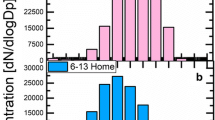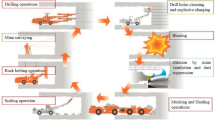Abstract
Activities associated with mining operations including smelting, ore handling, and mine tailings management have been identified as sources of dust and aerosol that may contain metal and metalloid contaminants, such as lead (Pb) and arsenic (As). Previous studies on contaminant transport have concentrated on the potential impact of these particulate emissions in outdoor environments. The purposes of this study were (i) to quantify the effect of dust and aerosol particle size on contaminant transport from outdoor-to-indoor environments and (ii) to document the changes in particle chemical composition during transport through the outdoor/indoor barrier. Outdoor and indoor particulate samples were collected at a high school equipped with mechanical air filtration systems from 2016 to 2019. The school is located near a set of mine tailings and an active copper smelter in Hayden, Arizona. Particle size segregated samples were collected using a ten-stage micro-orifice uniform deposit impactor (MOUDI). Results show that airborne fine particles (aerodynamic diameters less than 1 micron) can penetrate to the indoor environment but in a reduced amount due to mechanical filtration. Aerosol in the fine fraction particulate air concentrations was around 50% of the corresponding outdoor values, but their mass concentration of contaminants was similar to outdoor values. Indoor coarse particles (> 1 micron) comprised close to 20% of the levels found in outdoor coarse particles. These results highlight the need to consider the impact of particle diameter when assessing indoor exposure and potential health effects in communities living under the direct influence of mining and smelter activities.










Similar content being viewed by others
References
Abt, E., Suh, H. H., Catalano, P., & Koutrakis, P. (2000). The relative contribution of outdoor and indoor particle sources to indoor concentrations. Environmental Science & Technology., 34, 3579–3587.
Arizona Department of Environmental Quality (ADEQ) (2019) Superfund Alternative Site | ASARCO Hayden Plant. https://www.azdeq.gov/node/1871. Accessed 21 May 2021.
American Society for Testing and Materials (2003) Standard practice for collection of settled dust samples using wipe sampling methods for subsequent lead determination. http://www.astm.org/Standards/E1728.htm. Accessed 21 May 2021.
Arizona Department of Health Services (2018) Arizona Department of Health Services Health Consultation: Evaluation of Community Exposure to Lead and Sulfur Dioxide in Air. Hayden and Winkelman Communities. https://www.atsdr.cdc.gov/HAC/pha/haydenWinkelman/ADHS_Hayden_Air_HC-508.pdf. Accessed 21 May 2021.
Chatoutsidou, S. E., Ondráček, J., Tesar, O., Tørseth, K., Ždímal, V., & Lazaridis, M. (2015). Indoor/outdoor particulate matter number and mass concentration in modern offices. Building and Environment, 92, 462–474.
Cheema, A. I., Liu, G., Yousaf, B., Abbas, Q., & Zhou, H. (2020). A comprehensive review of biogeochemical distribution and fractionation of lead isotopes for source tracing in distinct interactive environmental compartments. Science of the Total Environment, 719, 135658.
Csavina, J., Landázuri, A., Wonaschütz, A., Rine, K., Rheinheimer, P., Barbaris, B., Conant, W., Sáez, A. E., & Betterton, E. A. (2011). Metal and metalloid contaminants in atmospheric aerosols from mining operations. Water, Air, & Soil Pollution, 221, 145–157.
Csavina, J., Field, J., Taylor, M. P., Gao, S., Landázuri, A., Betterton, E. A., & Sáez, A. E. (2012). A review on the importance of metals and metalloids in atmospheric dust and aerosol from mining operations. Science of the Total Environment, 433, 58–73.
Csavina, J., Taylor, M. P., Félix, O., Rine, K. P., Sáez, A. E., & Betterton, E. A. (2014). Size-resolved dust and aerosol contaminants associated with copper and lead smelting emissions: implications for emission management and human health. Science of the Total Environment, 493, 750–756.
Cyrys, J., Pitz, M., Bischof, W., Wichmann, H. E., & Heinrich, J. (2004). Relationship between indoor and outdoor levels of fine particle mass, particle number concentrations and black smoke under different ventilation conditions. Journal of Exposure Analysis and Environmental Epidemiology, 14, 275–283.
Del Rio-Salas, R., Ruiz, J., De laVillanueva, M., Valencia-Moreno, M., Moreno-Rodríguez, V., Gómez-Alvarez, A., Grijalva, T., Mendivil, H., Paz-Moreno, F., & Meza-Figueroa, D. (2012). Tracing geogenic and anthropogenic sources in urban dusts: Insights from lead isotopes. Atmospheric Environment, 60, 202–210.
Dong, C., Taylor, M. P., & Zahran, S. (2019). The effect of contemporary mine emissions on children’s blood lead levels. Environment International, 122, 91–103.
EPA (2020) Hazard Standards and Clearance Levels for Lead in Paint, Dust and Soil (TSCA Sections 402 and 403). https://www.epa.gov/lead/hazard-standards-and-clearance-levels-lead-paint-dust-and-soil-tsca-sections-402-and-403. Accessed 21 May 2021.
EU (2004) Relating to arsenic, cadmium, mercury, nickel and polycyclic aromatic hydrocarbons in ambient air. Official Journal of the European Union. https://eur-lex.europa.eu/legal-content/EN/TXT/?qid=1486475021303&uri=CELEX:02004L0107-20150918. Accessed 21 May 2021.
Faure, G. (1986). Principles of isotope geology. Wiley.
Félix, O. I., Csavina, J., Field, J., Rine, K. P., Sáez, A. E., & Betterton, E. A. (2015). Use of lead isotopes to identify sources of metal and metalloid contaminants in atmospheric aerosol from mining operations. Chemosphere, 122, 219–226.
Finkelstein, Y., Markowitz, M. E., & Rosen, J. F. (1998). Low-level lead-induced neurotoxicity in children: An update on central nervous system effects. Brain Research Reviews, 27, 168–176.
Geagea, M. L., Stille, P., Millet, M., & Perrone, T. (2007). REE characteristics and Pb, Sr and Nd isotopic compositions of steel plant emissions. Science of the Total Environment, 373, 404–419.
Geller, M. D., Chang, M., Sioutas, C., Ostro, B. D., & Lipsett, M. J. (2002). Indoor/outdoor relationship and chemical composition of fine and coarse particles in the southern California deserts. Atmospheric Environment, 36, 1099–1110.
González-Castanedo, Y., Moreno, T., Fernández-Camacho, R., de la Campa, A. M. S., Alastuey, A., Querol, X., & de la Rosa, J. (2014). Size distribution and chemical composition of particulate matter stack emissions in and around a copper smelter. Atmospheric Environment, 98, 271–282.
Landrigan, P. J., & Baker, E. L. (1981). Exposure of children to heavy metals from smelters: epidemiology and toxic consequences. Environmental Research, 25, 204–224.
Loh, M. M., Sugeng, A., Lothrop, N., Klimecki, W., Cox, M., Wilkinson, S. T., Lu, Z., & Beamer, P. I. (2016). Multimedia exposures to arsenic and lead for children near an inactive mine tailings and smelter site. Environmental Research, 146, 331–339.
Marple, V. A., Rubow, K. L., & Behm, S. M. (1991). A microorifice uniform deposit impactor (MOUDI): Description, calibration, and use. Aerosol Science and Technology, 14, 434–446.
Mohammed, M. O. A., Song, W. W., Ma, W. L., Li, W. L., Ambuchi, J. J., Thanit, M., & Li, Y. F. (2015). Trends in indoor–outdoor PM2.5 research: A systematic review of studies conducted during the last decade (2003–2013). Atmospheric Pollution Research, 6, 893–903.
Rasmussen, P. E., Levesque, C., Chénier, M., & Gardner, H. D. (2018). Contribution of metals in resuspended dust to indoor and personal inhalation exposures: Relationships between PM10 and settled dust. Building and Environment, 143, 513–522.
Sorooshian, A., Csavina, J., Shingler, T., Dey, S., Brechtel, F. J., Sáez, A. E., & Betterton, E. A. (2012). Hygroscopic and chemical properties of aerosols collected near a copper smelter: Implications for public and environmental health. Environmental Science and Technology, 46, 9473–9480.
Soto-Jimenez, M. F., & Flegal, A. R. (2011). Childhood lead poisoning from the smelter in Torreón, México. Environmental Research, 111, 590–596.
Stovern, M., Guzmán, H., Rine, K. P., Felix, O., King, M., Ela, W. P., & Betterton, A. E. (2016). Windblown dust deposition forecasting and spread of contamination around mine tailings. Atmosphere, 7, 16.
Tasić, V., Kovačević, R., Maluckov, B., Apostolovski-Trujić, T., Matić, B., Cocić, M., & Šteharnik, M. (2017). The content of As and heavy metals in TSP and PM 10 near copper Smelter in Bor, Serbia. Water, Air and Soil Pollution, 228, 230.
Viana, M., Rivas, I., Querol, X., Alastuey, A., Álvarez-Pedrerol, M., Bouso, L., Sioutas, C., & Sunyer, J. (2015). Partitioning of trace elements and metals between quasi-ultrafine, accumulation and coarse aerosols in indoor and outdoor air in schools. Atmospheric Environment, 106, 392–401.
Witten, M. L., Chau, B., Sáez, A. E., Boitano, S., & Lantz, R. K. (2019). Early life inhalation exposure to mine tailings dust affects lung development. Toxicology and Applied Pharmacology, 365, 124–132.
Xu, H., Guinot, B., Cao, J., Li, Y., Niu, X., Fai, K., Shena, Z., Liu, S., Zhangb, T., Lei, Y., Zhang, Y., Suna, J., & Gao, J. (2018). Source, health risk and composition impact of outdoor very fine particles (VFPs) to school indoor environment in Xi’an, Northwestern China. Science of the Total Environment, 612, 238–246.
Author information
Authors and Affiliations
Corresponding author
Additional information
Publisher's Note
Springer Nature remains neutral with regard to jurisdictional claims in published maps and institutional affiliations.
Rights and permissions
About this article
Cite this article
Rodríguez-Chávez, T.B., Rine, K.P., Almusawi, R.M. et al. Outdoor/Indoor Contaminant Transport by Atmospheric Dust and Aerosol at an Active Smelter Site. Water Air Soil Pollut 232, 226 (2021). https://doi.org/10.1007/s11270-021-05168-2
Received:
Accepted:
Published:
DOI: https://doi.org/10.1007/s11270-021-05168-2




